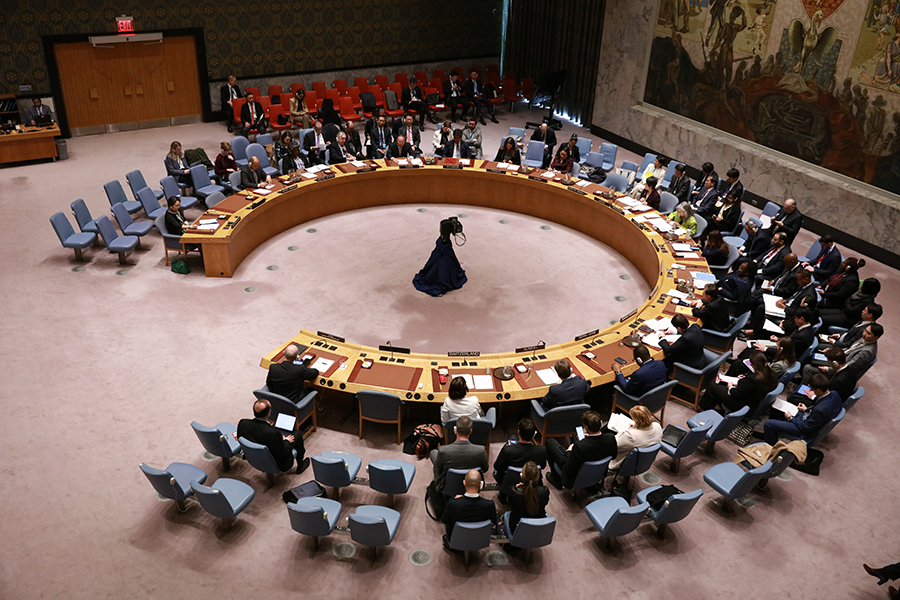“For half a century, ACA has been providing the world … with advocacy, analysis, and awareness on some of the most critical topics of international peace and security, including on how to achieve our common, shared goal of a world free of nuclear weapons.”
Breaking the Impasse on Disarmament, Part One
April 2024
By Daryl G. Kimball
A special UN Security Council meeting on nuclear disarmament issues convened by Japan in March underscored agreement among all 15 members that the risk of nuclear war and arms racing is higher than at any point since the end of the Cold War. But it also highlighted chronic differences among the nuclear-armed states about how to reduce the danger. As the Japanese foreign minister warned ahead of the meeting, “The world now stands on the cusp of reversing decades of declines in nuclear stockpiles.”
 To address such challenges, UN Secretary-General António Guterres outlined several commonsense, achievable steps that could begin to move the world away from the nuclear precipice if pursued by China, Russia, the United States, and others.
To address such challenges, UN Secretary-General António Guterres outlined several commonsense, achievable steps that could begin to move the world away from the nuclear precipice if pursued by China, Russia, the United States, and others.
Noting that “states possessing nuclear weapons are absent from the table of dialogue,” Guterres said they “must reengage” to reduce nuclear stockpiles, prevent nuclear use, negotiate a joint no-first-use agreement, stop nuclear saber-rattling, and reaffirm support for the 1996 Comprehensive Test Ban Treaty.
He put specific emphasis on countries with the largest arsenals, Russia and the United States, and said that they “must find a way back to the negotiating table to fully implement the [New Strategic Arms Reduction] Treaty [New START] and agree on its successor.”
Last month, more than two dozen members of Congress introduced an important resolution calling for stronger U.S. efforts to engage Russia and China in arms control talks. Moving the nuclear-armed states in the right direction will, however, require much stronger and sustained pressure from civil society, legislators, and the international community.
At the Security Council meeting on March 18, U.S. Ambassador Linda Thomas-Greenfield criticized Russia’s nuclear rhetoric and reiterated the 2023 U.S. offer to engage in bilateral talks with Moscow on a post-New START nuclear arms control framework. Unsurprisingly, Russia’s delegate renewed the Kremlin’s rejection of the U.S. offer, claiming that there is no basis for such work if Western countries refuse to “respect [Russia’s] vital interests.”
In reality, maintaining limits on their strategic nuclear arsenals is in the vital interest of both countries. Yet, New START, the last remaining bilateral arms control treaty, is due to expire in fewer than 675 days. Moreover, Russia and the United States are obligated under Article VI of the nuclear Nonproliferation Treaty (NPT) to engage in negotiations to halt the arms race and move toward disarmament.
NPT member states should make it their highest priority at the NPT preparatory committee meeting in July to press Moscow and Washington to observe the New START limits on deployed warheads until a more permanent, comprehensive nuclear arms control arrangement is concluded.
Thomas-Greenfield also called out China’s nuclear buildup and said that, despite a round of bilateral talks in November, China “remained unwilling to engage in substantive talks on nuclear risk reduction and arms control.”
China’s delegate agreed that “the risk of a nuclear arms race and a nuclear conflict is rising,” but insisted that U.S. criticisms of China “don’t hold water.” He invited other nuclear-armed states to explore the possibility of a no-first-use agreement.
China’s proposal is designed, of course, to highlight its long-standing no-first-use posture and divert attention from its nuclear buildup. Nevertheless, such an agreement would help reduce nuclear risk. As U.S. President Joe Biden said in October 2022 about Russia’s threat of a potential first use of nuclear weapons in Ukraine, “I don’t think there’s any such thing as the ability to easily [use] a tactical nuclear weapon and not end up with Armageddon.” The same logic applies to U.S. or Chinese first use.
If the United States wants more substantive dialogue with China, the White House should agree to seriously discuss China’s proposal and say the United States does not plan to threaten nuclear coercion against China. Such a shift could reduce tensions and lead to more concrete measures designed to prevent a Chinese-U.S. nuclear arms race.
Guterres also called for reforms at the Conference on Disarmament (CD) to open the way for long-delayed talks on a fissile material cutoff treaty (FMCT) and on legally binding negative security assurances against nuclear attack for non-nuclear-weapon states, a priority for most nations.
To advance progress at the CD, the United States indicated in February that it would drop its opposition to talks on legally binding assurances against nuclear attack for non-nuclear states in good standing with their NPT commitments if other states, including China and Pakistan, drop their objections to long-delayed talks on an FMCT. Such a quid pro quo, if accepted by Beijing, could jump-start CD activity and lead to tangible results that reduce nuclear risks and guard against unconstrained arms buildups.
The world has faced grave nuclear dangers before. Then as now, it will take strong domestic and international pressure, smart diplomacy, and some luck to prevent disaster.
